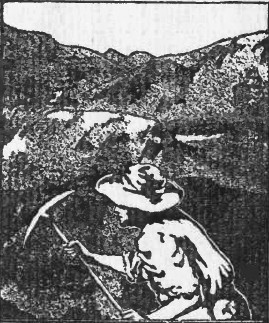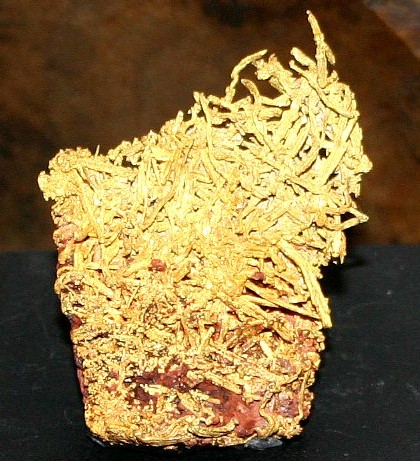The explorer should be familiar in theory at least with the locality where he may expect to find valuable minerals. For instance, should he be searching for some heavy, detached substance that is usually found in placer deposits he will keep to the low ground and examine carefully the beds of the streams. On the other hand, should his quest be for some ore that is more properly a component of a lode or vein he will examine the side hills and summits where denudation will certainly have exposed such deposits. Then he must know the appearance of each ore, and with the methods of making rough and ready tests he must be perfectly familiar.
Gold is always more or less intimately associated with quartz. Oxide of tin is said never to have been found more than two miles from some granite rock, one of the components of which was muscovite or white mica. The junction of slates and schists with igneous or metamorphic rocks often proves a valuable find of mineral. Rocks for the purposes of the explorer may be grouped under three heads: Igneous; metamorphic; stratified. The first includes lavas; trachytes, grayish with rough fracture and mainly glassy; dark basalts; and traps, such as greenstone. Obsidian is a volcanic glass. Metamorphic rocks are thought to have once been stratified, but to have been altered by heat. They comprise granite, of quartz feldspar and mica; syenite, containing hornblende instead of mica; gneiss, like granite, but showing lines of stratification; mica schist, made up of mica and quartz and separating easily into layers; slates.
Stratified rocks are those deposits from water, such as sandstone, limestone, clay, etc. A prospecting shaft need not be of large dimensions. One 4 feet square is amply large for any depth down to 30 feet, but it must be kept plumb. Sometimes shafts are sunk through the pay streak in alluvial gravel, without it being detected. Frequent panning will guard against this mistake. In the Klondike region it is said early prospectors missed very rich deposits, that have since been discovered, by stopping short of true bedrock, being misled by a bed of harder gravel that they thought was bottom. Silver almost invariably carries some gold. The dark ironstone hat already referred to is a good indication of silver ore beneath; it is generally composed of conglomerates cemented by oxides of iron and manganese. Galena, which is sometimes so rich in silver as to be worth working for that metal, may often be followed by surface indications; namely, a white limy track with detached fragments of float ore in the surface soil. The blowpipe or fire assay quickly determines silver ore.
Tin in lode, stream, or alluvial deposits occurs only as an oxide, but its appearance is varied. It may be almost any color and shape. It is always near granite, containing white mica known as muscovite. The magnetic or dipping needle is used in New Jersey, as follows, according to the State Geologist, W. H. Scranton, M. E.: "An attraction which is confined to a very small spot and is lost in passing a few feet from it, is most likely to be caused by a boulder of ore or particles of magnetite with rock. An attraction which continues on steadily in the direction of the strike of the rock for a distance of many feet or rods, indicates a vein of ore; and if it is positive and strongest towards the southwest, it is reasonable to conclude that the vein begins with the attraction there. If the attraction diminishes in going northwest, and finally dies out without becoming negative, it indicates that the vein has continued on without break or ending until too far off to move the compass needle. If, in passing towards the northwest, along the line of attraction, the south pole is drawn down, it indicates the end of the vein or an offset. If, on continuing further, still in the same direction, positive attraction is found, it shows that the vein is not ended, but if no attraction is shown, there is no indication as to the continuance of the ore.
"In crossing veins of ore from southwest to northwest, when the dip of the rock and ore is as usual to the southeast, positive attraction is first observed to come on gradually, and the northwest edge of the vein is indicated by the needle suddenly showing negative attraction just at the point of passing off it. This change of attraction will be less marked as the depth of the vein is greater, or as the strike is nearer north and south. The steadiness and continuance of the attraction is a much better indication of ore than the strength or amount of the attraction. The ore may vary in its susceptibility to the magnetic influence from impurities in its substance; it does vary according to the position in which it lies, that is according to its dip and strike; and it also varies very much according to its distance beneath the surface." Further instructions are given in the paper from which the foregoing extract was taken, some of which follow:
"It is sufficient to say that the first examinations are made by passing over the ground with the compass in a northwest and southwest direction, at intervals of a few rods, until indications of ore are found. Then the ground should be examined more carefully by crossing the line of attraction at intervals of a few feet, and marking the points upon which observations have been made, and recording the amount of attraction. Observations with the ordinary compass should be made, and the variation of the horizontal needle be noted. In this way materials may soon be accumulated for staking out the line of attraction, or for constructing a map for study or reference.
"After sufficient exploration with the magnetic needle, it still remains to prove the value of the vein by uncovering the ore, examining its quality, measuring the size of the vein, and estimating the cost of mining and marketing it. Uncovering should first be done in trenches dug across the line of attraction, and carried quite down to the rock. When the ore is in this way proved to be of value regular mining may begin. In places where there are offsets in the ore, or where it has been subject to bends, folds, or other irregularities, so that the miner is at fault in what direction to proceed, explorations may be made with the diamond drill,"
Continue on to:
Prospecting For Natural Gold
Return To:
Gold and Silver Prospecting Basics


